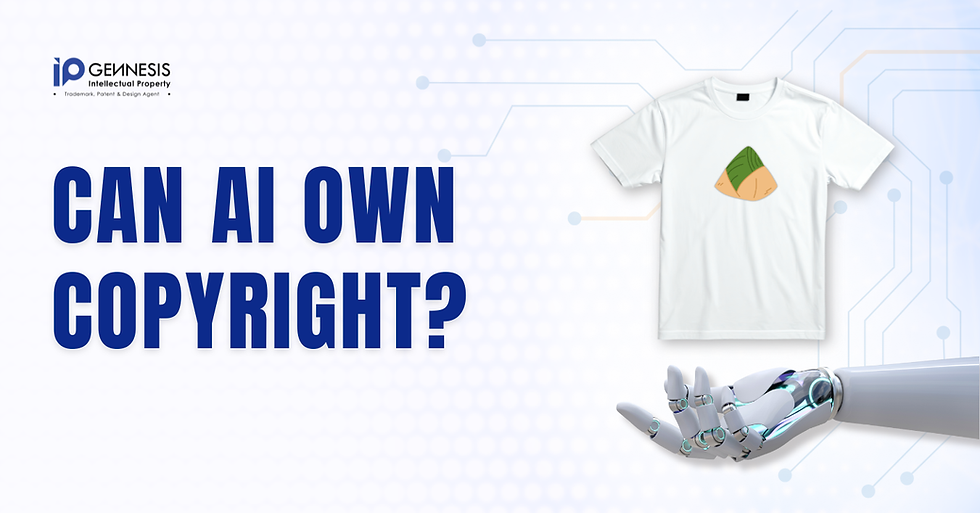The Rise of Generative AI: A Global Patent Landscape
- IP Gennesis

- Jul 5, 2024
- 3 min read
Generative Artificial Intelligence (GenAI) is transforming industries and redefining technological capabilities across the globe. According to the World Intellectual Property Organization's (WIPO) Patent Landscape Report on GenAI which was just published on 3.7.2024, GenAI patent filings have seen exponential growth, with China leading the charge. This article delves into the top countries in GenAI patent filings, the types of GenAI models, the main data types used, and the key application areas for these groundbreaking technologies.

Leading Countries in GenAI Patent Filings
China has emerged as the global leader in GenAI patent filings, boasting more than 38,000 patent families. This significant lead reflects China's robust investment in AI research and development, positioning it at the forefront of AI innovation.
The United States follows with approximately 6,300 patent families. The U.S. remains a crucial player in AI advancements, driven by leading tech companies and academic institutions.
The Republic of Korea has about 4,155 patent families, highlighting its strong commitment to technological innovation and AI research.
Japan contributes around 3,409 patent families, continuing its legacy of technological prowess and innovation.
India rounds out the top five with about 1,350 patent families, showcasing its growing influence in the global AI landscape.
Types of Generative AI Models
GenAI models are diverse and tailored for different applications. The main models include:
(a) Generative Adversarial Networks (GANs)
GANs consist of a generator and a discriminator. The generator creates data, such as images, while the discriminator evaluates the authenticity of the generated data. This dynamic is widely used for image generation and enhancement.
(b) Variational Autoencoders (VAEs)
VAEs encode input data into an intermediary representation and then decode it back into a new data sample. They are instrumental in generating realistic image samples.
(c) Large Language Models (LLMs)
LLMs, like OpenAI's GPT models, are trained on vast datasets to generate coherent and contextually relevant text. They are essential in chatbots and natural language processing tasks.
(d) Autoregressive Models
These models predict the next value in a sequence based on previous values. They are used in language generation, image synthesis, and other generative tasks.
(e) Diffusion Models
Inspired by physical diffusion processes, these models iteratively refine random noise to generate meaningful data. They are particularly effective in tasks like text-to-image generation.
Main Data Types in Generative AI
Generative AI models utilize various data types to produce their outputs:
Image/ Video: Models enhance or translate images and videos, generate high-resolution images from text, and create captions for visual content.
Text: LLMs generate text for applications such as text completion, translation, summarization, and conversational systems.
Speech/ Sound/Music: Models like DeepMind's WaveNet produce realistic human speech and other audio forms. MusicML generates music from text prompts.
3D Image Models: Techniques like Neural Radiance Fields (NeRF) reconstruct 3D scenes from 2D images, applicable in medical imaging and augmented reality.
Chemical Molecules/ Genes/ Proteins: Models create new chemical structures, aiding drug discovery and biological research.
Code/ Software: Tools assist in code generation, completion, and explanation based on natural language descriptions.
Key Application Areas for GenAI Patents
Generative AI patents span various industries, showcasing the technology's versatility and impact. The key application areas include:
Software: Enhancing software capabilities and development processes.
Life Sciences: Accelerating drug discovery and personalized medicine.
Document Management and Publishing: Automating document processing and content creation.
Business Solutions: Improving customer service, data analysis, and operational efficiency.
Industry and Manufacturing: Optimizing production processes and product design.
Transportation: Advancing autonomous driving and transportation systems.
Security: Enhancing cybersecurity measures and surveillance systems.
Telecommunications: Innovating communication technologies and network management.
Conclusion
The WIPO Patent Landscape Report highlights the dynamic growth and broad applicability of GenAI technologies. As countries like China, the United States, South Korea, Japan, and India lead the way in patent filings, the future of generative AI looks promising. These innovations are not only transforming industries but also paving the way for new applications and advancements in AI.
If you're considering filing GenAI patents or want to learn more about this transformative technology, contact us today!
Written by,
Registered Trademark, Patent and Design Agent
LL.B (HONS), CLP
Advocate & Solicitor (Non-Practising)
Disclaimer: The above are meant for general information purposes and do not constitute legal advice. Please do not hesitate to contact us if we could be of assistance!
© 2024 by IP Gennesis Sdn Bhd.







Comments